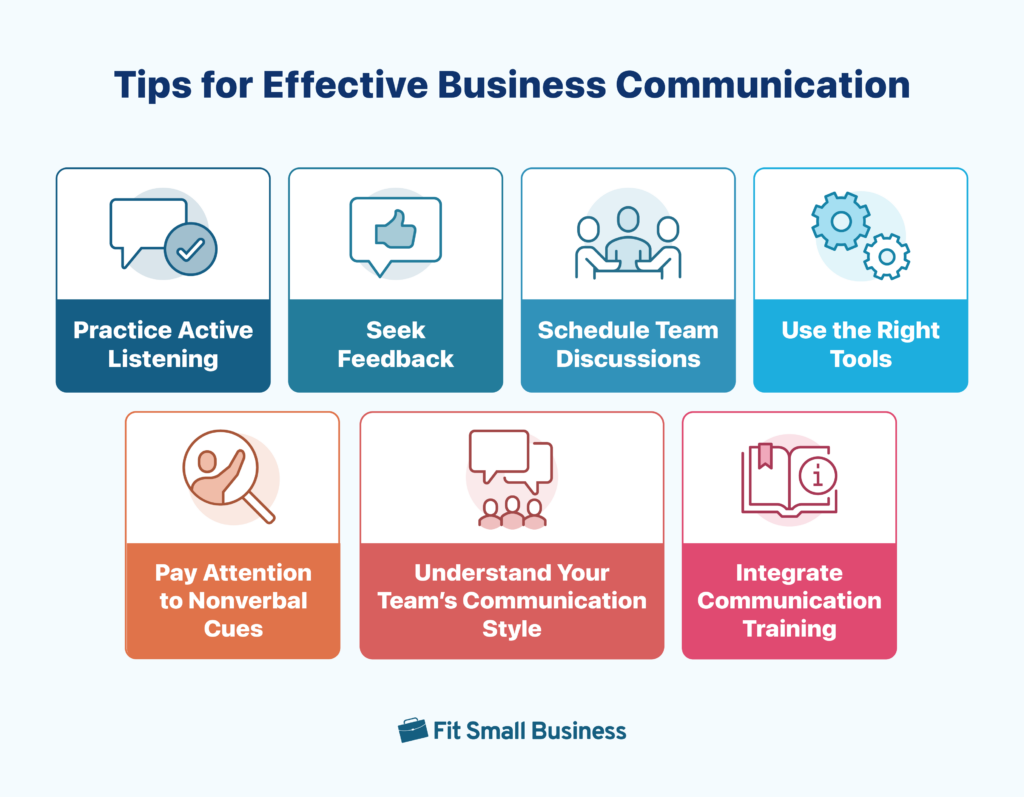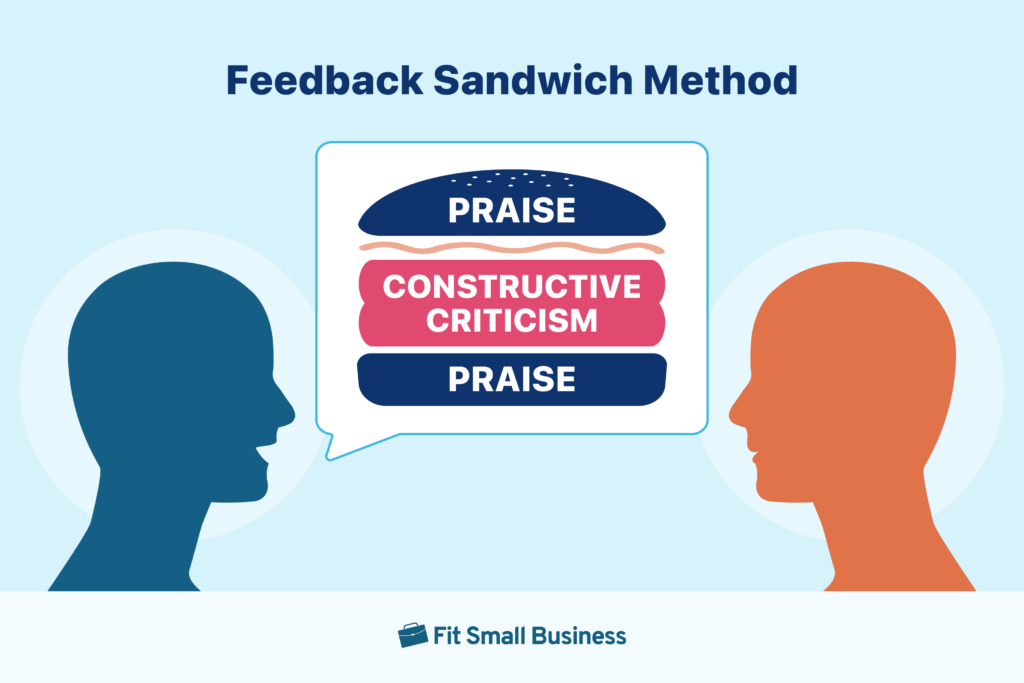Effective business communication refers to sharing information within a company in a manner the intended audience clearly understands. It calls for strategies like active listening, asking for feedback, and using the right communication tools. These are critical to maximizing work productivity, resolving conflicts, and enhancing team performance. In this guide, we listed seven expert tips for effective business communication and how to drive positive workplace interactions.

1. Integrate Communication Training
While much of our work is done online, communication skills should still be a priority. Hosting communication training or peer-led workshops helps employees refine their skills and adapt their communication strategies to various situations, both online and offline.
Communication workshops may delve into the various soft skills, including empathy, active listening, negotiation, and conflict resolution. Employees can also explore the different aspects of verbal communication, such as subtle tone variations, word choice, and inflection.
By providing relevant learning resources, employers promote a culture of continuous learning. This empowers employees to become better communicators, effectively conveying their ideas and ensuring their messages are processed and understood by their colleagues.
2. Practice Active Listening
Learning the art of active listening is a critical strategy for effective business communication. It involves the process of giving your full concentration without interrupting the speaker or thinking about what to say next. In other words, it goes beyond merely hearing, but also asking questions and engaging in the conversation itself.
Being an active listener avoids the risk of missing key information or asking the speaker to repeat what was said, which are all pitfalls of miscommunication. There are several techniques to improve your listening skills, including note-taking, making eye contact, removing distractions, and repeating or rephrasing what is being said.
With these effective business communication strategies, you’re able to recall specific details and maximize engagement during conversations. This attentiveness can help in building a level of trust and respect, improving your overall business relationships.
3. Understand Your Team’s Communication Style
Research shows that diverse workplaces are inherently more prone to misunderstandings because each member’s communication styles are largely shaped by their unique values and cultural backgrounds. For instance, some employees are more straightforward during meetings while others need more time to think about what to say.
To determine a person’s communication style, consider the DiSC model, which stands for dominance, influence, steadiness, and conscientiousness. It is a popular framework used for understanding preferences and tendencies in workplace settings. Encouraging employees to take a DiSC assessment lets you identify each team member’s unique collaboration, leadership, and conflict management approach.
Paying attention to a person’s communication style fosters stronger workplace relationships and improves your interpersonal skills. However, before learning how your team members prefer to communicate, it’s important to understand your communication style first.
4. Seek Feedback
Asking superiors and team members for feedback is an excellent way to gain insights about your communication style. They can share their thoughts and concerns about your message delivery, providing you with ideas on where to improve and create clear communication strategies.
Setting up regular feedback loops promotes workplace transparency and enables everyone to adapt to the team’s evolving needs and communication challenges. Feedback collection can be done through surveys, meetings, and suggestion boxes.

To provide balanced feedback, use the feedback sandwich technique—start with positive feedback, followed by constructive criticism, and then conclude with another positive feedback. This approach preserves the confidence and motivation of the team member while allowing them to be aware of their shortcomings.
Want to create a feedback-driven culture at work? Our guide on how to give workplace feedback shares key strategies for promoting an environment that inspires healthy communication.
5. Pay Attention to Nonverbal Cues
A University of Texas study revealed that nonverbal communication heavily influences how people react to information. This means that communication goes far beyond speech and is also concerned with how we deliver it. Nonverbal cues, such as body language, gestures, facial expressions, and posture, play an important role in how information is interpreted.
Paying attention to nonverbal cues empowers us to refine our messaging and avoid giving off unintentional cues that have nothing to do with the situation. For example, smiling and leaning forward demonstrate engagement and openness, while arms crossed over the chest signal defensiveness and a more closed-off attitude.
To ensure you’re sending the right signals, here are common body language mistakes you need to avoid at work:
- Glancing at your watch or phone frequently during meetings
- Constant fidgeting like nail biting, hair twirling, and knuckle cracking
- Excessive hand movements during presentations
- Avoiding eye contact during conversations
- Weak handshake
- Poor posture or slouching
Attuning to nonverbal cues allows us to adapt our communication style and ensure our message aligns with the intended meeting. If you want to project confidence in meetings, try techniques like standing tall, making eye contact, and keeping your hands visible.
6. Schedule Team Discussions
Taking the time to build workplace relationships cultivates more intentional relationships, especially among remote teams. Do this by scheduling enough time each month for team meetings and one-on-one sessions and dedicate these discussions specifically for check-ins and open communication.
Use the first few minutes of the meeting to ask participants about their week or share things that keep them busy. This helps them feel more at ease in the conversation and be more comfortable to voice out their ideas and concerns. Being transparent with employees builds trust and encourages them to do the same by sharing openly with you in return.
7. Use the Right Communication Tools
A 2024 Grammarly business report saw that the increase in volume, pace, and communication channels caused employees to feel overwhelmed and unproductive. While having separate channels for each type of interaction is good, this can eventually lead to inefficiencies. Therefore, it’s important to carefully invest in communication tools that maximize productivity without hurting employee morale.
With more teams embracing remote or hybrid models, the type of communication tool used directly impacts team dynamics and business outcomes. These tools vary from a range of options, such as video conferencing software, team chat apps, and voice-over-internet-protocol (VoIP) systems.
Unified communications (UC) is a centralized workspace integrating voice, video, messaging, fax, and email. With a unified solution, teams can communicate and share information in a more streamlined manner while reducing the need for app switching and paying for separate apps.
Like any business software, proper training is necessary to ensure everyone is comfortable integrating these tools into their workflow. UC systems vary in features and scalability, so we curated a list of the top six providers catering to different business needs.
Unified Communications Providers | Monthly Starting Price (per User) | Key Features | Learn More |
|---|---|---|---|
$30 |
| ||
 | $30.95 |
| |
$23 |
| ||
 |
| ||
 | $15.99 |
| |
 | $14.50 |
| |
New to unified communications? Onboard your teams seamlessly with our comprehensive guide on using unified communications and collaboration tools efficiently.
Benefits of Effective Business Communication
Effective communication within a business has a significant impact on all aspects of its operations, including team productivity, engagement, culture, and conflict management. Let’s take a look at some ways in which good workplace communication can drive your company to success.
- Greater employee engagement: Proper communication is vital in employee engagement as it encourages feedback, strengthens personal connections, and ensures a clear understanding of the company’s goals. Employees who are guided by their managers with clarity are more likely to align their skills and efforts toward achieving shared objectives.
- Improved productivity: When instructions and updates are clearly communicated across the organization, employees are more likely to perform and understand their roles better. Clarity reduces the need for back-and-forth communication, allowing teams to focus on tasks requiring more attention.
- Better team collaboration: Honest and open communication makes team collaboration more effortless by driving employees to be actively involved in discussions and decision-making. Plus, using cloud communications platforms equips teams with the right tools to stay in touch and collaborate effectively on projects regardless of their locations.
- Transparency: Maintaining regular communication with employees keeps them well-informed about company changes, announcements, and developments, reducing the likelihood of misunderstandings and rumors. This fosters a more trustworthy work environment, where information is openly shared among employees.
- Fewer workplace conflicts: Conflicts are less likely to occur in the workplace if employees take the time to listen and consider individual differences. With the right communication skills, employees are able to handle disagreements respectfully and come up with mutually beneficial solutions.
Frequently Asked Questions (FAQs)
Communication silos, cultural differences, lack of transparency, and information overload are some of the common issues in business communication. Recognizing these challenges is necessary for companies to address them effectively. To mitigate these issues, employ strategies like promoting transparency, providing cultural sensitivity training, and encouraging open communication.
The 7 Cs of effective communication are: clear, correct, complete, courteous, concise, concrete, and coherent. These seven Cs serve as a guide to communicating effectively through different mediums and enhance effective communication in business.
There are plenty of ways to deal with a difficult coworker, and one of them involves direct communication. Voicing your thoughts allows you to confront the situation professionally while gaining insights into their perspective.
However, in doing so, make sure to follow tips on effective business communication by being mindful of your nonverbal cues and choice of words. If it doesn’t work, escalate the problem with your supervisor or human resources department so they can take the appropriate action.
Bottom Line
Effective business communication is essential for building workplace relationships, managing conflicts, and conveying ideas clearly. Whether you’re managing a small business or a large organization, seeking feedback, practicing active listening, and using the right tools can help optimize your communication efforts in your team. By following the tips above, your business can successfully create a culture of collaboration, transparency, and innovation.